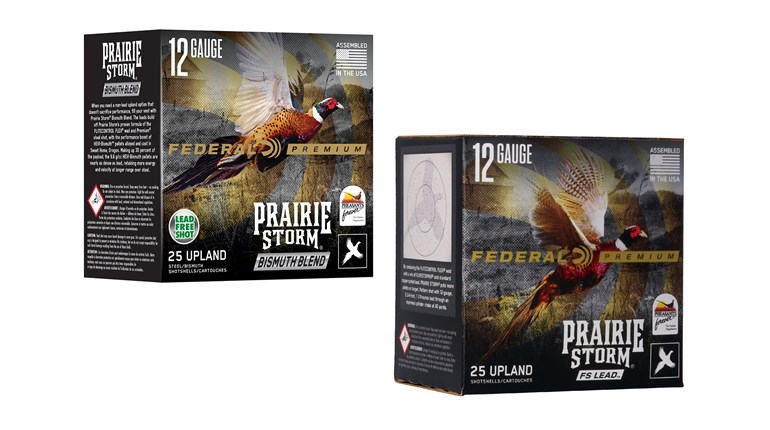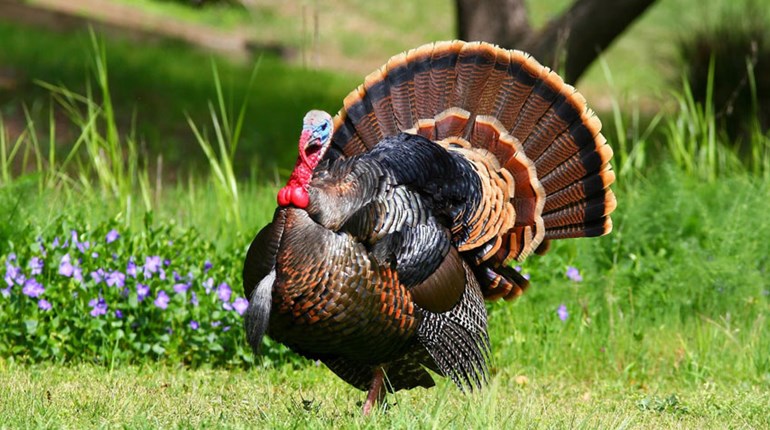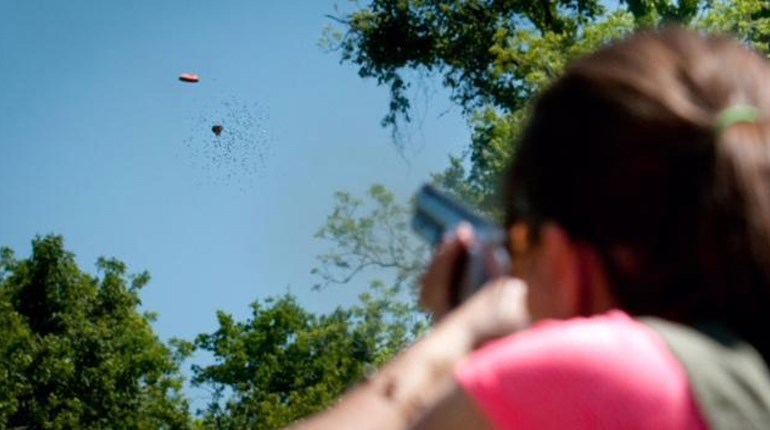Ruble dashed down into the rock-strewn serpentine course that was once the bed of Lawyer Creek, nose glued to the damp November ground. Guide Ian Privette and I followed, staying above the dry channel as Ruble, like a heat-seeking missile, coursed toward the pheasant, chukar or Hungarian partridge—or some combination thereof—that had taken refuge there.
A covey of Huns rocketed out of the cut ahead of the English pointer, much too far away for a shot, and landed on the other side of today’s Lawyer Creek. Elsewhere on the Flying B Ranch, Lawyer Creek still meanders, but this stretch was re-routed years ago into a straight wash hemmed tight to the wall of Lawyer Canyon to make way for a hayfield. Marking their landing area, we pushed ahead until Ruble juked, circled and went on point over a mound of ancient lava rocks, the remnants of vast basalt lava flows that ultimately formed the Columbia Plateau.
I stayed high as Ian dropped into the bed. As he closed in, a cock pheasant cackled and erupted from his hideout, arching high overhead, the bird’s iridescent plumage contrasting with the retreating morning fog that hung like a halo over the canyon’s stark gray walls.
The rooster cartwheeled end-over-end as soon as the Weatherby hit my shoulder, landing in a patch of canary grass to my left. Ruble scooped up the bird and deposited him at his master’s feet, and before I could insert a fresh shell into my SA-08, he was on point again.
“We’ve got another point over here,” Ian instructed, still tucking the pheasant into his vest.
The pheasant flushed wild and flew dead away from us, then turned to set his wings and sail down the valley. I swung the gun to match his pace and mashed the trigger when the brass front bead reached the edge of his head. The bird crumpled and fell to the ground.
“Nice shot!” Ian shouted. “That had to have been close to 50 yards.”
“I think I’m starting to get a little cocky with this gun,” I said, nearly forgetting that I was shooting a 28-gauge.
“I think those Huns landed in the rocks on the far side of the creek, not too far from the chukar we flushed earlier,” said Ian. “Let’s see if Ruble can hunt ’em up.”
Ruble was already chest-deep in the rushing water when we reached the bank. He searched the far side to no avail, so Ian began tossing rocks across the creek in an attempt to flush the birds.
“I wonder if those birds hit the ground and ran,” said the guide. “If they got up in that thick cover on the slope, it’s going to be hard to get to them.”
Just then Ruble ranged farther ahead to a point where the creek and canyon wall met, flushing the fast-flying Huns around the point and up into the cover high above the water.
“Looks like they did run,” I said, “just farther up the creek than we realized. Not that we had much of a shot at them; those birds were awfully spooky.”
“That chukar landed somewhere around here,” Ian replied, calling the pointer back to our side of the creek. “Let’s see if Ruble can find him.”
In short order Ruble found the chukar hidden in tall grass, and the partridge was heading back toward the dry creek bed when three-quarters of an ounce of No. 8 shot from Federal’s Wing-Shok load interrupted its flight.
■■■
Located in the Idaho panhandle, the Flying B Ranch (flyingbhunting.com) is an Orvis- and NRA Outdoors-endorsed hunting and fishing outfit in the heart of the Nez Perce Indian Reservation. In addition to being a bird hunter’s Mecca (hunters take 25,000 birds off the Flying B each year), the ranch operates big-game hunts for virtually all of the Western staples—mule deer, elk, black bears, mountain lions and a surprisingly large number of whitetails.
You may remember a 2012 uproar that saw former California Fish and Game Commission president Dan Richards stripped of his office for legally hunting and killing a mountain lion in Idaho, the head-scratching reason being that mountain lion hunting is illegal in California. Yep, that hunt took place at the Flying B.
Perhaps more historically significant, the ranch also served as a stopover point for Meriwether Lewis and William Clark on their journey to the Pacific in September 1805. As the story goes, upon reaching the meadows along the Clearwater River drainage inhabited by the Nez Perce, Lewis and Clark were befriended by the Nez Perce chief Twisted Hair, who gave them food and shelter, helped them find suitable timber for canoes and armed the explorers with information on the route ahead.
Twisted Hair’s fishing village was located in Lawyer Canyon along Lawyer Creek, not far from the present-day Flying B lodge, in roughly the same area Ian and I were hunting.
Both canyon and creek are named after Twisted Hair’s son, Lawyer.
Upon retrieving the chukar, Ian and I circled back to the truck where we met Roger Whitchurch, a retired narcotics detective, gunsmith, world-class storyteller and current quality control/product development guru for Weatherby. Roger, who was instrumental in the development of the SA-08 Deluxe 28-gauge guns we were using, had sat out our push down the flat to rest his ailing back and neck, but he rejoined us as we hunted back toward the lodge.
As we advanced, you could almost envision the scene: smoke curling above the Nez Perce lodges; children staring in wonderment at the strange, haggard men who had descended upon their village; Lewis and Clark’s men, nearly starving, hungrily devouring dried salmon and camas bread; the vast canyon filled with the grazing horses of the Nez Perce, a tribe known for its ability as horsemen; those same horses being traded for goods, perhaps even guns.

We were literally following in the footsteps of Lewis and Clark, and the sense of history was palpable.
Catching movement to my right, I turned just in time to see a pair of quail flush wild from the base of a brush-choked road embankment at the edge of the flat. Figuring they probably weren’t alone, we moved in and the remainder of the covey, perhaps 10 birds, rose and smartly flew to the safety of a barn and bunkhouse on the other side of the road. Realizing our mistake, I got up on the gravel road to cut off that escape route. Rather than more quail, Ruble flushed a pair of pheasants from the briars. The pair split, with Roger dropping the low rooster and I the high bird.
Up until that point, Roger and I had been shooting so well that we looked like a regular pair of John Satterwhites. But even a trick shooter could be excused for missing a Hun every now and then, so fast do the partridges fly. However, at the far end of the flat, feeding under some irrigation equipment just below the lodge, we sent a dozen Huns skyward. We didn’t just miss one Hun; we emptied our guns on the birds, managing two hits from our six shots.
Already tardy for a planned late-morning rendezvous farther up the canyon with Weatherby’s Tim Frampton and fellow scribe Terry Wieland, we watched helplessly as the rest of the birds sailed down the valley, unscathed, and disappeared into the overgrown serpentine of Chief Lawyer’s creek.
■■■
Human habitation of northern Idaho dates back some 10,000 years, at least according to cave paintings found inside a rock shelter on the Flying B property. Not far from that cave lies an ancient trail known to the Nez Perce and early pioneers as Shununway Draw, and that afternoon we slowly threaded our way up its steep track to reach the top of Lawyer Canyon.
For two days we had hunted the ranch’s fertile bottoms and hillsides with great success, but guide Jim McManus offered to take Roger and I “up top,” so I could get some photos of the countryside. The view was nothing short of awe-inspiring.
From our bird’s-eye perch we could see the nearby town of Kamiah (pronounced Kam-ee-eye), the Flying B lodge and virtually the entirety of Lawyer Canyon. Behind us lay the Camas Prairie and the distant peaks of the mighty Bitterroot Mountains, through which Lewis and Clark had traveled via the treacherous Lolo Trail.
We started out hunting chukar on the rocky, windswept slopes of the upper canyon in what has to be one of the prettiest wingshooting backdrops in the country. From there we moved out the ridge to an expansive plateau covered in a variety of grasses, brambles and scattered stands of pine. It’s nickname is Homestead Heights, and I was immediately taken by the area’s stillness. The only sound was the crisp fall wind rustling through the trees.
We hadn’t gone 50 yards when Sophie, Jim’s crack point-and-retrieve Brittany, lowered her head and began creeping toward the edge of the rise. Sophie’s two high-motor kennel mates, German shorthairs Lurch and June, rushed in for backup. Jim moved in for the flush, and the rooster came out like a prize fighter before Roger dropped him into a copse of pines.
Through intensive management, the Flying B is working to return the entire ranch to its natural state, which means the eradication of non-native cover like star thistle, but as fate would have it, our next point came amid the prickly stuff. I sent the chukar tumbling into the patch, and no sooner had June brought the bird to my hand when Jim hollered that Lurch was on point on the other side of the thick, nasty cover. I circled the briars to join him, where we flushed a pair of Hungarian partridge, folding the first bird but whiffing on the second.
June hadn’t emerged from the briars, and wouldn’t you know it, she was on point again, steps from where my chukar had just landed. The patch was almost impenetrable, but I circled back to an old road on the lip of the ridge, hoping the narrow alley between the pines would give me room for a shot.
The bird began to run and June gave chase, instinctively flushing it out of the thicket. The pheasant came crashing out of the tangle, and I threw the gun to my shoulder, knocking it out of the air as soon as it entered my shooting lane. It landed in the road, and I saved June the trouble of making the retrieve.
We hunted on in similar fashion for the remainder of the afternoon, flushing birds as they came and generally hitting more than we missed, until the light began to fade and our game bags grew satisfyingly heavy.
But across the canyon, the opposing hillside was still lit up in brilliant sunshine.
“Do you see the ridge over there?” Jim asked, pointing. “Lewis and Clark came right down off the point on that ridge on their return trip from the Pacific.”
While waiting for the snow to melt in the Bitterroots, Lewis and Clark’s Corps of Discovery again camped with the Nez Perce in Lawyer Canyon in the spring of 1806 before crossing the Continental Divide and descending onto the Great Plains. I looked at that ridge, its grass-covered slopes golden in the late-afternoon sunlight, and envisioned the men of the Corps, footsore and weary, coming over the top with their Harpers Ferry Model 1792 flintlocks and Girandoni air rifle in tow, eager to re-claim their horses, which Twisted Hair had agreed to hold for them during their long canoe ride down the Columbia River to the coast.
As beautiful as the valley looked to me in that moment, I’m sure its prospect of food and shelter looked even better to that ragtag band of explorers some 200 years ago.Even today, for the thrill-seeking hunter, there are few places as wild, ruggedly stunning and full of adventure as northern Idaho’s canyon country. At the Flying B, amongst all of that beauty lies a history so rich that without it the story of our country could not be fully told. To walk where Lewis and Clark once walked, to hunt where man has hunted for centuries, who could ask for more?





































